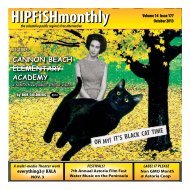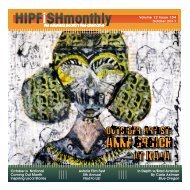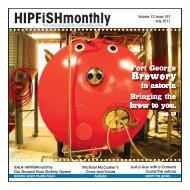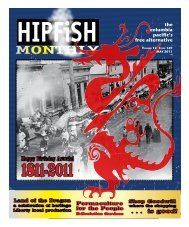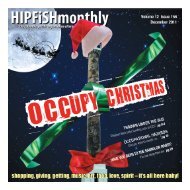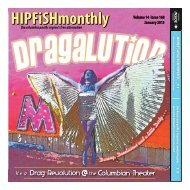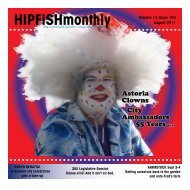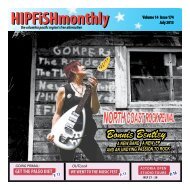IN NEW LIGHT - HIPFiSHmonthly
IN NEW LIGHT - HIPFiSHmonthly
IN NEW LIGHT - HIPFiSHmonthly
Create successful ePaper yourself
Turn your PDF publications into a flip-book with our unique Google optimized e-Paper software.
“When The Brothers Four started out at the University of<br />
Washington in Seattle we were totally “powered” by the Martin<br />
Tenor Guitar. It was the sound of our first 2 or 3 albums recorded<br />
for Columbia Records., including our first single release,<br />
“Greenfields”. As I think back on it now it seems likely that the<br />
trademark sort of open-stringed arpeggio introduction to that recording<br />
would have not been possible on anything else but those<br />
two Tenor Guitars. A lucky moment!”<br />
Bob Flick<br />
The Brothers Four<br />
“I’ve been playing a 1954 Martin Tenor<br />
Guitar since 2006. A bout with tendonitis<br />
in the left elbow caused me to quit playing<br />
the six string guitar for about a year. I<br />
bought 1954 Martin to see if the smaller<br />
instrument would help with the elbow. I<br />
always loved what Nick Reynolds played on<br />
his tenor guitar, so it was an easy decision<br />
for me to try one out. The elbow healed,<br />
the 1954 Martin is fine, and singing partner<br />
for the past 53 years, Bill Murlin and I<br />
have worked the Tenor into our Wanderers<br />
act full time. We look forward to bringing<br />
the Martin to Astoria in June!”<br />
Carl Allen, The Wanderers<br />
“I came to tenor guitar through mandolin,<br />
after playing guitar for 15 years I picked<br />
up a mando and started writing songs on<br />
it, then began to do solo shows again and<br />
wanted to play those songs, but not so<br />
tiny-sounding. My vintage Martin Tenor has a lovely deep tone<br />
for such a small instrument, and I swear it is haunted, in a good<br />
way, by whatever songs got played on it in it’s youth (the ‘30’s<br />
and ‘40’s.) I have written a few songs on it that feel like they<br />
were given to me by the instrument, most especially the song<br />
Ruby Warbler, that I named my band after. So glad to be coming<br />
back to the Gathering, a great chance to get together with other<br />
fans of this sweet instrument.”<br />
Myshkin<br />
Words from Mark Joseph<br />
Tenor Guitar Gathering Organizer<br />
grew up in Atlantic City, New Jersey<br />
I and started playing guitar in 1960 when<br />
I was ten years old. Playing chords came<br />
easy and I evolved into a sought after<br />
rhythm guitar player. I played rhythm<br />
guitar and sang in a four piece rock band<br />
called “the Super Jam Blues Band”, and<br />
later, “The Whazooz”. We played for High<br />
School dances and private “sweet sixteen”<br />
parties. When I graduated from High<br />
School I graduated to playing in bars. In<br />
1974 I joined a swing trio and we were<br />
an opening act for Ry Cooder, Randy<br />
Newman, Horace Silver, Sonny Terry and<br />
Brownie McGee and numerous others. I<br />
met Johnny Shines, Professor Longhair,<br />
Walter “Shakey” Horton, Bucky Pizzarelli<br />
during that time and learned a little bit<br />
from observation. It was a magical time in<br />
my life, “pre straight job”, so to speak.<br />
My Mom bought me a harmonica when<br />
I was 18. I learned what I know today<br />
from meeting harp players much better<br />
than I, who took the time to share invaluable<br />
techniques that you can hear in my<br />
recordings and live playing. When<br />
I was 40, I started playing the<br />
ukulele, similar to guitar but very different<br />
in the musical approach....and<br />
bought my first tenor guitar when I was<br />
50 years old. I just finished an album<br />
that’s all about the tenor guitar. It’s<br />
called “TENOR ELEVEN”, fifteen songs<br />
played on tenor guitar with vocal and<br />
harmonica accompaniment.<br />
I never saw myself as a promoter,<br />
and still don’t, but I do feel the desire<br />
to bring tenor guitar players together<br />
at one time and one place, and that<br />
place is Astoria. Music continues to be<br />
special to me. It has opened doors to<br />
new friendships and improves the quality<br />
of my life. I have worked in Los Angeles<br />
as a clerk at an Outpatient Cancer Center<br />
and will bring my uke in and play for patients.<br />
It makes them sing and smile and<br />
forget where they are for a moment. It is<br />
uplifting to them and to me as well.<br />
I spoke to a stranger on the phone<br />
recently who’s coming to this year’s<br />
gathering. He told me he plays baritone<br />
ukulele and is thinking about playing the<br />
tenor guitar. When he searched the web<br />
“The more people are talking about tenors, the more people<br />
are playing them. I’m spreading the word everywhere I go. I’m at<br />
the Jazz Festival in New Orleans right now, and I can tell you that<br />
everyone here loves the tenor.”<br />
Spider Murphy<br />
“ The two most common questions I’m asked about the tenor<br />
guitar are, “Why a tenor guitar” and “What’s the difference<br />
between a tenor guitar and a 6 string” The answer is an easy<br />
one. The tenor guitar has a clear, sweet voice of it’s own. It<br />
works beautifully as a rhythm instrument,<br />
as part of a section or as a stand along<br />
solo instrument. I play a Martin size 5 or<br />
half size tenor from 1929, a new Martin<br />
Custom tenor, a National Reso-phonics<br />
tenor with a steel body and an archtop<br />
electric tenor made by Paul Lestock of<br />
Arrow Guitars and Mandolins. Each guitar<br />
has it’s own personality and history.<br />
I went to the Library of Congress and<br />
The Smithsonian to research tenor guitars<br />
and players when the tenor first grabbed<br />
my attention and heart. About 75% of<br />
the players I found were black musicians<br />
from the early black string bands from the<br />
1920s through about 1935. They were<br />
centered in the Midwest around Chicago<br />
and St. Louis and also in Louisiana and<br />
Alabama.<br />
I’m thankful for the players and builders who are breathing<br />
new life into the instrument today. The tenor guitar is a<br />
voice from our American past that reaches beautifully into the<br />
future. It’s a voice that could have been lost but thanks to the<br />
efforts of Mark Josephs, Paul Lestock, Josh Reynolds, Dick Boak<br />
and many others in the modern music community the tenor<br />
guitar will be with us for a long time to come.”<br />
Marcy Marxer – Two Time Grammy Winner<br />
Spider Murphy<br />
for information he came across the gathering.<br />
He booked himself into the Hotel<br />
Elliot and is very excited about attending.<br />
That’s the kind of thing that makes me<br />
hustle to make these gatherings happen,<br />
and the fact that they’re a lot of fun for<br />
me and everyone who attends. I think that<br />
everyone in Astoria has worked together<br />
to make this quirky event come to life,<br />
it’s not unlike a band that rehearses for<br />
hours and then gets on stage and puts<br />
that wall of emotion out there as if it was<br />
all so easy.<br />
and<br />
What is Permanent<br />
Cosmetic Makeup<br />
• Permanent cosmetic makeup is a nonsurgical<br />
method of applying colored pigment<br />
to enhance eyes, lips, and eyebrows with a<br />
soft, natural finish that looks like<br />
perfectly applied makeup.<br />
• Permanent cosmetics can beautifully define<br />
facial features, correct the appearance<br />
of many imperfections, and improve your<br />
overall appearance. Offering a new kind of<br />
personal freedom, permanent cosmetics will<br />
make your life easier.<br />
Call for a Consultation<br />
503.338.5555<br />
At Spa La Cost<br />
in Astoria<br />
Acustica<br />
World Music<br />
Sat May 12 . 7-9pm<br />
Ladies Night<br />
thursdays $5 pours<br />
wine . beer . bites . live music<br />
The wine bar<br />
in the club house at<br />
Peninsula Golf Course<br />
thur-sat 4-10pm<br />
9604 Pacific Hwy<br />
Long Beach, WA<br />
(360) 642-2828<br />
thecoveatnight.com<br />
FEATUR<strong>IN</strong>G<br />
Local instrumentalists<br />
Lawrence Aldred, David<br />
Ambrose, Randy Brown and<br />
Richard Thomasian under the<br />
direction of Dr. Denise Reed with<br />
accompanist Debbie Loyd<br />
7:00 pm, Saturday, May 19 and<br />
2:00 pm, Sunday, May 20<br />
Clatsop Community College<br />
PerformingArts Center at<br />
588 16th Street in Astoria<br />
“The Art of Possibility: Jazz and Community Building” on May 8, at<br />
7:30 pm at the CCC Performing Arts Center. Tim DuRoche will speak<br />
and lead a discussion.<br />
The Conversation Project is made possible by the generous support of the Oregon<br />
Humanities, the National Endowment for the Humanities and the Oregon Cultural Trust.<br />
Darcy Wiegardt<br />
Permanent Cosmetics<br />
Technician<br />
licensed & certified<br />
Permanent Cosmetics<br />
“Always Look Your Best!”<br />
11 may12 hipfishmonthly.com



